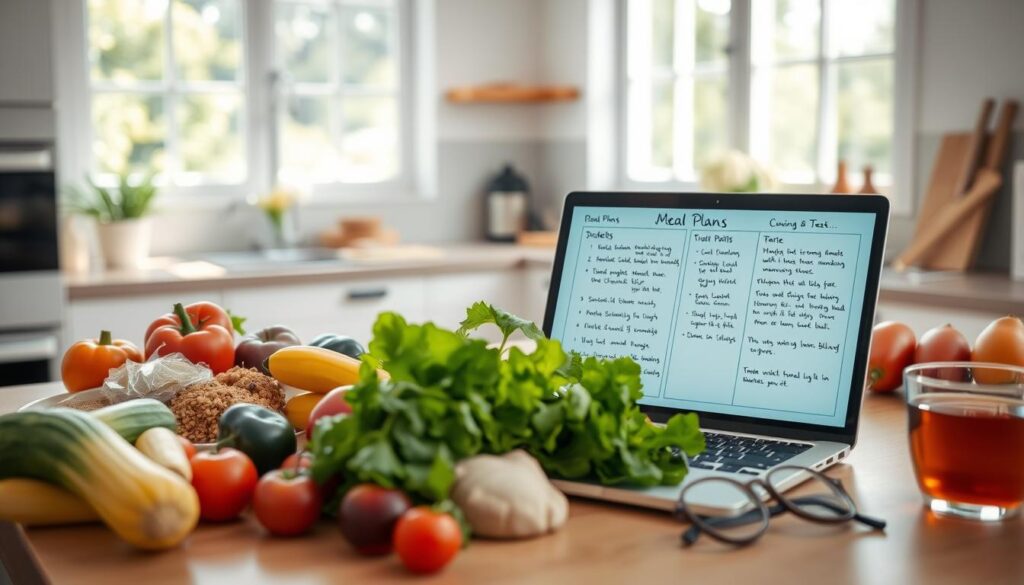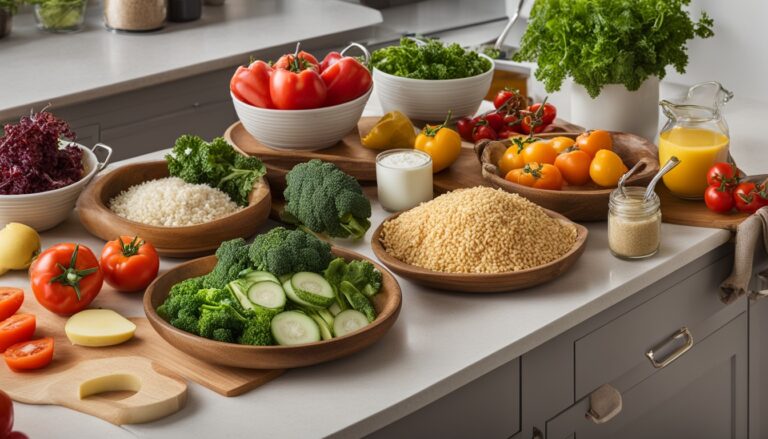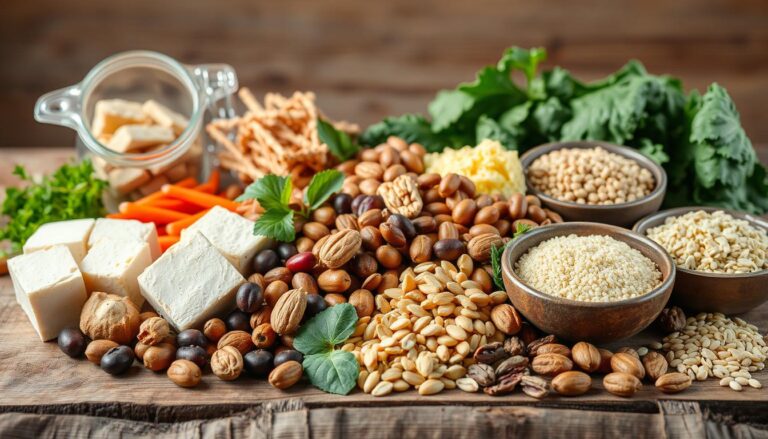What if the right meal plan could transform your blood sugar levels without feeling restrictive? For those living with diabetes smart food choices play a crucial role in maintaining balance.
The American Diabetes Association ADA emphasizes personalized approaches over one size fits-all diets.
Sustainable habits, like carb management and portion control, make a lasting difference. Instead of quick fixes, focus on long-term strategies that fit your lifestyle. This ensures steady glucose levels while enjoying a variety of foods.
Key Takeaways
- Personalized meal plans improve blood sugar control.
- The ADA recommends flexible, science backed eating patterns.
- Balanced carb intake helps stabilize glucose levels.
- Portion control supports sustainable weight management.
- Long-term habits matter more than short-term restrictions.
How Nutrition Impacts Type 2 Diabetes Management
Smart food decisions directly influence glucose stability and overall well-being. For those with diabetes every meal either supports or challenges the body’s ability to manage blood sugar. Research from the ADA confirms that tailored eating patterns improve A1C levels more effectively than generic diets.
The Role of Consistent Blood Sugar Management
Stable glucose levels reduce risks like neuropathy and vision loss. The NIH warns that carb-heavy meals cause sharp spikes, straining pancreatic function over time. Small, daily adjustments like choosing whole grains over refined carbs add up to significant protection.
Why Long Term Food Choices Matter
Proactive eating habits preserve insulin sensitivity better than reactive fixes. A study in the ADA Standards of Care found patients with personalized meal plans had 30% fewer complications. The table below contrasts outcomes:
| Approach | Blood Sugar Stability | Complication Risk |
|---|---|---|
| Proactive planned meals | Steady glucose | Low |
| Reactive unplanned eating | Frequent spikes | High |
Prioritizing nutrient dense foods supports lasting health. Lean proteins, fiber rich veggies, and healthy fats work together to maintain balance without deprivation.
Understanding Carbohydrates and Blood Sugar
Not all carbs are created equal some fuel steady energy, while others cause rapid spikes. The body converts carbohydrates into glucose, directly affecting blood sugar levels. Choosing wisely can mean the difference between stability and chaos.

Carbohydrates and Their Impact on Glucose
NIH research confirms that breads, rice, and sweets cause immediate glucose surges. Pairing carbs with protein or fat as the ADA suggests slows absorption. This prevents sharp spikes and supports long-term balance.
Simple vs Complex Carbohydrates
Simple carbs, like fruit juice or candy, digest quickly and spike blood sugar. Complex carbs, such as quinoa or sweet potatoes release energy slowly. The table below highlights differences:
| Type | Examples | Glycemic Impact |
|---|---|---|
| Simple | Soda, white bread | High rapid spike |
| Complex | Barley, lentils | Low steady rise |
Why Fiber Matters
Fiber, especially soluble fiber, forms a gel during digestion. This slows glucose absorption and improves satiety. Aim for 25–30g daily from sources like:
- Oats and chia seeds
- Broccoli and Brussels sprouts
- Whole grains brown rice, farro
Small swaps like choosing an apple over juice add fiber and reduce sugar crashes. Consistency is key to lasting results.
Creating a Diabetes Friendly Meal Plan
A well-designed meal plan turns food into your ally against blood sugar swings. The ADA emphasizes personalized approaches, like DSMES programs, to tailor meals to your needs. Working with experts ensures your plan fits your lifestyle and health goals.
Collaborating with a Diabetes Educator
A diabetes educator or dietitian helps design a plan that aligns with medications and daily routines. Key questions to ask during consultations:
- How should meals be timed with insulin or metformin?
- What portion sizes work best for my activity level?
- Can traditional foods e.g. Mediterranean or Asian dishes be adapted?
Balancing Macronutrients for Stability
The ADA recommends dividing your plate to optimize energy and glucose control. Here’s a science-backed ratio:
| Macronutrient | Percentage | Examples |
|---|---|---|
| Carbohydrates | 40% | Quinoa, berries, beans |
| Protein | 30% | Grilled chicken, tofu, fish |
| Fats | 30% | Avocado, nuts, olive oil |
NIH research notes that pairing carbs with protein or fats slows digestion, preventing spikes. For example, pair an apple with almond butter for balanced energy.
The Plate Method A Simple Approach to Balanced Meals
Balancing meals doesn’t require complex math just a simple visual guide. The American Diabetes Association ADA recommends dividing a 9-inch plate into three sections for optimal glucose control. This method prioritizes nutrient density without strict calorie counting.
Fill Half Your Plate with Non Starchy Vegetables
Non-starchy veggies are low in carbs and high in fiber, making them ideal for steady blood sugar. Aim for variety and color with these ADA-approved options:
- Spinach, kale, and Swiss chard
- Broccoli, cauliflower, and Brussels sprouts
- Bell peppers, zucchini, and asparagus
Lean Protein Portions and Choices
Protein should occupy a quarter of your plate. Opt for low-saturated-fat sources to support heart health. Compare these options:
| Protein Source | Saturated Fat per 3 oz |
|---|---|
| Skinless chicken breast | 1g |
| Salmon | 1.5g |
| Extra-lean ground beef | 2.5g |
Smart Carb Selections for the Remaining Quarter
Reserve the last quarter for carbohydrates with a low glycemic impact. Visualize portions:
- ½ cup cooked quinoa ≈ computer mouse size
- 1 small sweet potato ≈ fist size
Pair meals with unsweetened iced tea or infused water for hydration without added sugar.
Portion Control Strategies That Work
Your hands aren’t just for eating they’re the perfect portion-measuring tools. The NIH confirms that visual cues like palm sizes or cupped hands eliminate guesswork. For steady blood sugar, consistency matters more than perfection.
Hand Based Measurements Made Simple
No scales? No problem. Use these ADA-approved estimates:
- 3 oz meat = Palm size deck of cards
- 1 oz nuts = Cupped hand
- ½ cup grains = Fist size
Studies show this method reduces overeating by 22% compared to eyeballing.
Navigating Restaurant Portions
Most meals serve 3–4 portions. Try these tactics:
- Split entrees or box half immediately.
- Order appetizers as mains.
- Skip bread baskets and free refills.
ADA data notes that restaurant dining spikes blood sugar 30% faster than home meals.
Precision Tools for Home Use
For accuracy, compare these options:
| Tool | Best For | Margin of Error |
|---|---|---|
| Digital scale | Proteins, grains | ±1g |
| Measuring cups | Liquids, flours | ±10% |
Keep a cheat sheet for common foods e.g., 1/4 cup quinoa = 32g . Small habits create big results over a day.
Foods to Emphasize for Better Diabetes Control
Choosing the right foods can be a game changer for blood sugar stability. The ADA prioritizes whole, nutrient-dense options over processed alternatives. Focus on these three categories to build balanced meals.

Powerhouse Vegetables and Their Benefits
Non-starchy vegetables rank highest in nutrient density. The ANDI score Aggregate Nutrient Density Index highlights top picks:
- Kale 1,000 ANDI : Rich in vitamins A, C, and K.
- Spinach 739 ANDI : High iron and folate content.
- Bell peppers 265 ANDI : Packed with antioxidants.
These low carb options provide fiber and slow glucose absorption.
Healthy Protein Sources: Fish Beans, and Lean Meats
Protein stabilizes energy and reduces carb cravings. Compare omega-3 content in fish:
| Fish Type | Omega-3s (per 3 oz) |
|---|---|
| Salmon | 1.8g |
| Tilapia | 0.1g |
For plant-based options, soak beans overnight to reduce phytates. NIH approved lean proteins include lentils, tofu, and egg whites.
Whole Grains vs. Refined Grains
Grains impact blood sugar differently. Whole wheat bread has a glycemic load GL of 9, while white bread scores 29. ADA-approved brands like Bob’s Red Mill offer minimally processed options.
Pair grains with proteins or fats to further slow digestion. For example, try quinoa with grilled chicken for lasting energy.
Foods and Beverages to Limit
Hidden ingredients in everyday foods can sabotage even the most careful meal plans. The NIH warns that sugary drinks, fried items, and excess sodium worsen glucose control. Learning to spot these culprits helps protect long-term health.
Decoding Added Sugars and Hidden Carbs
Labels list sugars under 57+ names, from barley malt to dextrose. The ADA advises checking for these common aliases:
- Syrups: Corn, rice, or malt syrup
- -ose endings: Fructose, sucrose
- Natural sweeteners: Agave, honey
Avoiding foods high in these additives prevents blood sugar spikes. Opt for whole fruits instead.
Processed Foods and Metabolic Risks
Processed foods often contain trans fats and excess salt. Compare these snacks:
| Snack | Trans Fat (per serving) |
|---|---|
| Microwave popcorn | 1.5g |
| Baked potato chips | 0g |
The NIH recommends herbs or vinegar as low-sodium alternatives to condiments.
Alcohol’s Impact on Glucose Levels
Moderation is key. The ADA allows 1 drink/day for women, 2 for men. Different types affect blood sugar differently:
| Drink | Carbs per serving |
|---|---|
| Dry wine (5 oz) | 4g |
| Margarita | 24g |
Track responses with the ADA’s 2-hour post-consumer glucose test for safety.
Long Term Strategies for Sustainable Eating
Building lasting habits is the foundation for steady blood sugar control. The ADA emphasizes consistency over rigid rules, allowing flexibility with food groups while maintaining balance. Small, practical adjustments make healthy choices second nature.

Meal Planning and Preparation Tips
A 4-week rotating menu simplifies decisions and reduces stress. The ADA’s template includes:
- Batch cooking proteins like grilled chicken for 3-4 meals
- Pre-portioning snacks into single servings
- Using frozen veggies to save time without losing nutrients
Studies show planning cuts impulsive eating by 40%. Keep emergency snacks like nuts or string cheese handy for busy days.
Adapting Cultural and Family Foods
Traditional dishes can fit into a balanced eating plan with smart swaps. The NIH suggests these modifications:
| Cuisine | Original Dish | Healthy Version |
|---|---|---|
| Mexican | White rice | Cauliflower rice |
| Italian | Pasta | Zucchini noodles |
| Asian | Fried rice | Quinoa stir-fry |
Experiment with herbs and spices to maintain flavor while reducing salt and sugar.
Managing Special Occasions and Dining Out
Restaurants don’t have to derail progress. Use this decision matrix:
- Appetizers: Choose veggie-based over fried
- Mains: Grilled or baked proteins with double veggies
- Desserts: Share one portion or opt for berries
The ADA’s program locator helps find diabetes-friendly eateries nationwide. Balance indulgent meals with lighter options the next day.
Conclusion: Taking Control of Your Diabetes Through Nutrition
Small, consistent changes create lasting results for blood sugar stability. The American Diabetes Association highlights personalized meal plans as the most effective way to reduce complications. Pairing this with NIH-backed strategies ensures steady progress.
Start with these actionable steps:
- Use the ADA’s health care directory to find a certified educator
- Swap refined grains for whole-food alternatives weekly
- Track meals and glucose responses to identify patterns
Research shows dietary adjustments lower risks by 40% over time. For support, visit the Diabetes Association’s resource hub. Every positive choice adds up to better outcomes.





